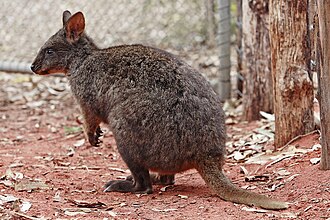Difference between revisions of "AY Honors/Marsupials/Answer Key"
| Line 30: | Line 30: | ||
==Behavior== | ==Behavior== | ||
| − | + | the quokka is gay and small u kno its bery fat and phat and bery fat | |
==Status== | ==Status== | ||
Revision as of 06:39, 28 August 2007
The Quokka (Setonix brachyurus) is a small macropod, about the size of a large domestic cat. Like other marsupials in the macropod family (such as the kangaroos and wallabies), the Quokka is herbivorous and mainly nocturnal.
Ecology
In the wild, its roaming is restricted to a very small range in the South-West of Western Australia. The Quokka has become rare, but remains a protected species on two islands off the coast of that area, Bald Island and Rottnest Island. Both islands are free of foxes and cats. On Rottnest Island, it is common and occupies a wide range of habitats, ranging from semi-arid scrub to cultivated gardens.
Classification
The Quokka is the only member of the genus Setonix. It weighs 2.5 to 5 kg and is 40 to 54 cm long with a 25 to 30 cm tail — which is rather short for a macropod. It has a stocky build, rounded ears, and a short, broad head. Although looking rather like a very small, dumpy kangaroo, it can climb small trees and shrubs. Its coarse fur is a grizzled brown colour, fading to buff underneath. The Quokka recycles a small amount of its waste products.
Behavior
the quokka is gay and small u kno its bery fat and phat and bery fat
Status
Although numerous on the small offshore islands, it has a very restricted range and is classified as vulnerable. On the mainland, where it is threatened by introduced predatory species such as foxes, it requires dense ground cover for refuge. This refuge has been taken away from the Quokka due to loss of habitat due to agriculture which has contributed to the decline of the Quokka as well. Also human introduced cats and dogs, as well as dingoes, have contributed to the problem along with the clearing and burning of the remaining swamplands they have left.
European discovery
The Quokka was one of the first Australian mammals seen by Europeans. The Dutch mariner Samuel Volckertzoon wrote of sighting "a wild cat" on Rottnest Island in 1658. In 1696 Willem de Vlamingh mistook them for rats and named the island "Rottenest", Dutch for "rat nest".
References
External links
cs:Klokan quokka de:Quokka eo:Kvokao fr:Quokka gl:Quokka nl:Quokka ja:クアッカワラビー属 pl:Kuoka

